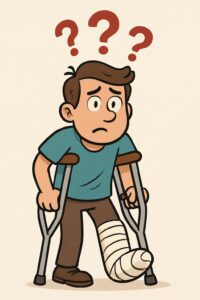When someone is injured due to another person’s negligence, one of the most common questions they have is: “What is my case worth?” There is no simple formula to determine the value of a personal injury claim. Each case is unique, and many factors are analyzed to arrive at a fair settlement or jury award. Below, we break down the key considerations that influence the value of a personal injury case.
________________________________________
1. Liability
Liability is the foundation of every personal injury case. Before assessing the value of damages, we must determine who was at fault and whether liability can be clearly established.
• If the defendant is 100% at fault, the value of your case is typically higher.
• If fault is shared (comparative negligence), the value may be reduced. For example, if you were found 20% at fault in a motor vehicle accident, your settlement could be reduced by that percentage under Massachusetts law.
________________________________________
2. Medical Diagnosis and Treatment
The severity and type of injury heavily influence case value. A soft tissue injury such as a sprain or strain is valued differently than a traumatic brain injury, fractured bones, or permanent nerve damage. Detailed medical records and expert opinions often play a critical role in documenting the extent of injuries.
________________________________________
3. Medical Bills
All reasonable and necessary medical expenses related to the accident are factored into the claim. This includes:
• Hospital and ER visits
• Diagnostic imaging (MRIs, CT scans)
• Surgeries
• Physical therapy and rehabilitation
• Prescription medications
Even future medical expenses, such as ongoing therapy or anticipated surgeries, can be included if properly documented by medical professionals.
________________________________________
4. Disability Periods
• Total Disability Periods: If the injury caused you to miss work entirely, the duration of this total disability will significantly affect your lost wage claim.
• Partial Disability Periods: If you were able to return to work on light duty or with restrictions, this partial disability period still represents a loss of earning capacity that must be accounted for.
________________________________________
5. Permanent Partial Disability (PPD)
Many injuries result in a permanent impairment, even after maximum medical improvement. A Permanent Partial Disability (PPD) rating, often expressed as a percentage, is an important factor in valuing long-term damages. For instance, a 15% permanent impairment of the dominant hand can affect a person’s career, hobbies, and daily life in ways that must be quantified.
________________________________________
6. Loss of Enjoyment of Life
Injuries do more than cause physical pain — they often disrupt the activities and experiences that bring meaning to life. This “loss of enjoyment” is considered a form of non-economic damage. Examples include:
• A new mother unable to lift or hold her baby due to a shoulder injury.
• A passionate golfer who can no longer swing a club after a back injury.
• A retiree who loved traveling but can no longer sit for long flights or walk through airports due to chronic pain.
________________________________________
7. Loss of Function
A permanent or temporary loss of bodily function, such as reduced range of motion, nerve damage, or difficulty performing routine tasks, adds to the overall value of the case. This is particularly relevant when the loss affects a client’s ability to work, pursue hobbies, or care for themselves and their family.
________________________________________
8. Client-Specific Impacts
No two clients experience the same injury in the same way. We carefully evaluate the personal impact of an accident. For example:
• A stay-at-home parent with a hand injury may struggle to cook, clean, or care for children.
• A construction worker with a back injury may face permanent career limitations.
• A young athlete with knee damage may lose scholarship opportunities or competitive potential.
________________________________________
9. Pain and Suffering
Pain and suffering damages compensate for the physical pain, emotional distress, and mental anguish caused by the injury. These damages are often subjective but can be powerfully demonstrated through client testimony, medical expert opinions, and documentation of the client’s day-to-day struggles.
________________________________________
10. Other Contributing Factors
Several other elements may influence case value, including:
• Prognosis: Whether the injury is expected to fully heal or result in ongoing symptoms.
• Pre-existing Conditions: Whether the accident aggravated a prior condition.
• Credibility and Evidence: Strong documentation, witness statements, and expert testimony all strengthen the claim.
________________________________________
Final Thoughts
Determining the value of a personal injury case is both an art and a science. It requires a thorough understanding of the client’s injuries, medical treatment, lost wages, and life impact — both now and in the future.
If you or a loved one has been injured due to someone else’s negligence, we can help you understand what your case might be worth and fight for the compensation you deserve.
Ready to Talk About Your Case?
Every personal injury case is unique, and the best way to understand what your claim might be worth is to talk with an experienced attorney who knows how to fight for full compensation. If you’ve been injured because of someone else’s negligence, don’t wait — call the Law Offices of Scott M. Syat, P.C. at (617)773-3500 for a free consultation . We’ll review your case, answer your questions, and help you take the next steps toward the recovery you deserve.
. We’ll review your case, answer your questions, and help you take the next steps toward the recovery you deserve.